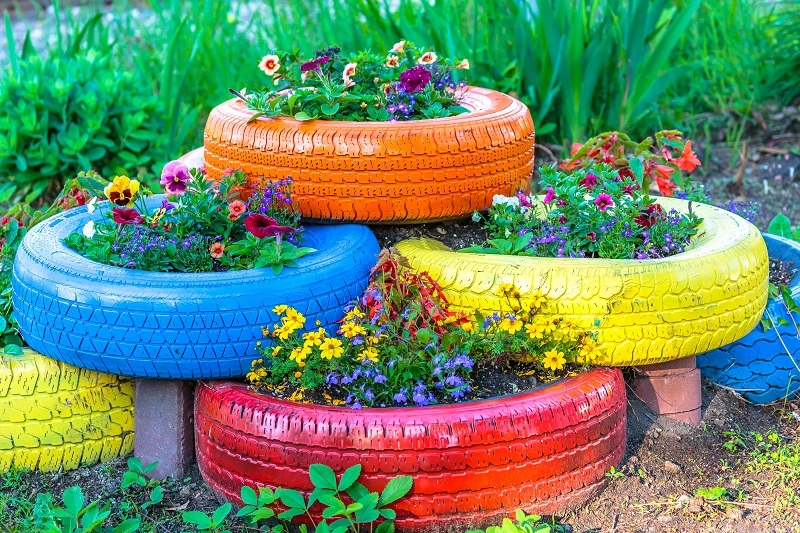Explode Your Floral Knowledge with These Tulip Facts
Posted on 18/08/2025
Explode Your Floral Knowledge with These Tulip Facts
Tulips are more than just beautiful blooms; they are living icons of history, culture, and nature's wonder. Whether you're a passionate gardener, amateur botanist, or simply someone who appreciates flowers, there's a world of fascinating tulip information waiting for you. In this comprehensive article, we'll explode your floral knowledge with these tulip facts, taking you on a journey through tulip history, varieties, cultivation secrets, cultural significance, and more!

What are Tulips? An Introduction to the Queen of Spring
The tulip (Tulipa) is a perennial, bulbous plant in the lily family (Liliaceae). Known for their bold colors and elegant form, tulips have been cherished throughout history and remain among the world's most beloved flowers. Their striking cup-shaped blooms brighten gardens after a long winter and symbolize the arrival of spring for flower enthusiasts worldwide.
Why are Tulips So Popular?
- Vibrant Variety: Over 3,000 registered varieties of tulips exist, featuring nearly every color except true blue.
- Symbolism: Tulips are often associated with love, rebirth, and prosperity.
- Easy Cultivation: Tulip bulbs are simple to plant and care for in most climates.
The Enchanting History of Tulips
Tulip facts would be incomplete without understanding their rich history. Tulips are native to central Asia, particularly areas that are now part of Kazakhstan, Afghanistan, and the surrounding regions. Nomadic tribes and traders carried tulips westward along the Silk Road, introducing them to the Ottoman Empire.
The Ottoman Obsession
The Ottomans were enthralled by tulips, considering them a symbol of perfection and paradise. Tulip motifs adorned everything, from palace gardens to elegant ceramics. The period was so influential that it earned the name "Tulip Era" (Lale Devri) in Ottoman history.
How Tulips Took Over Europe
Tulips first arrived in Western Europe via the diplomat Ogier Ghiselin de Busbecq in the 16th century, who brought bulbs from Constantinople to Vienna. Soon, the craze spread through the Netherlands, France, and England.
What Was Tulip Mania?
Tulip Mania was the first financial bubble and burst in history! In 1637, tulip bulbs fetched astronomical prices on the Dutch stock exchange, some costing as much as a house. When the market crashed, fortunes were lost overnight, but the nation's love for tulips endured.The Science Behind the Beauty: Botanical Tulip Facts
Understanding Tulip Anatomy
- Bulb: Unlike seeds, tulips grow from underground storage organs called bulbs.
- Leaves: Thin, lance-shaped, and waxy to help conserve water.
- Flower: Classic cup or star shape, composed of six tepals (petals and sepals that look alike).
- Stamens: Inside the bloom, six stamens surround the pistil (female reproductive part).
The Tulip Life Cycle: From Bulb to Bloom
- Planting (Fall): Bulbs go in the ground before winter's chill.
- Root Development: Roots form while the soil is cool.
- Winter Dormancy: Bulbs "chill," which is crucial for flowering.
- Spring Sprout: Tulip foliage emerges as temperatures rise.
- Blooming: Flowers burst into color, usually between March and May.
- Seed Formation: If not deadheaded, tulips set seeds after blooming.
- Bulb Multiplication: Bulbs can split, forming "offsets," which grow into new plants.
Tulip Types and Stunning Varieties
Did you know that tulips are divided into 15 official groups based on their origin, shape, and bloom time? Here are some standout selections to further explode your floral knowledge with these tulip facts:
Popular Tulip Varieties
- Single Early: Classic, sturdy blooms in early spring.
- Double Late: Sometimes called "peony tulips," densely petaled for a lush look.
- Parrot Tulips: Wildly ruffled petals, available in bright, variegated colors.
- Fringed Tulips: Unique, lacy-edged blossoms for a modern flair.
- Viridiflora: With distinct green streaks on their petals.
- Rembrandt Tulips: Once prized for their beautiful, feathered variegation caused by a harmless virus.
- Kaufmanniana and Greigii: Early bloomers with spectacular mottled foliage and colors.
Are Black Tulips Real?
True black tulips are a gardener's fantasy; the famous 'Queen of Night' is one of the darkest purple varieties but not completely black. The quest for a true black tulip inspired horticulturists for centuries with stunning near-black results.
Where Do Tulips Grow Best? - Cultivation Tips
Ideal Growing Conditions for Tulips
- Climate: Tulips need a period of cold dormancy, making them ideal for temperate areas.
- Soil: Well-draining is a must; tulips dislike soggy roots.
- Sunlight: Full sun ensures strong stems and bold colors.
- Space: Plant bulbs at least 4-6 inches apart and 6-8 inches deep.
Pro Gardener Tips: Explode Your Tulip Knowledge
- Chill Out: If you live in a warm climate, pre-chill bulbs in the refrigerator for 8-12 weeks before planting.
- Plant Once, Enjoy for Years: Some varieties, especially Darwin Hybrids, perennialize and return each season.
- Let Foliage Fade: Resist cutting leaves until yellow and dry, as this helps bulbs store energy for next year.
Tulip Events and Worldwide Celebrations
Tulips facts go beyond the garden -- these blooms are celebrated around the globe in spectacular style!
Tulip Festivals
- Keukenhof Gardens (Netherlands): The world's largest flower garden, with millions of tulips flowering in spring.
- Canadian Tulip Festival (Ottawa): A gift of gratitude from the Dutch royal family after World War II began this annual spring celebration.
- Skagit Valley Tulip Festival (USA): Washington State's incredible display of color draws hundreds of thousands of visitors each April.
Tulips in Art, Literature, and Symbolism
Tulips have been a muse for artists, writers, and decorators for centuries. Here's why:
- Art: Dutch Golden Age painters, like Rembrandt and Jan Brueghel, immortalized tulip displays in their still-life masterpieces.
- Literature: Tulips have appeared in poetry and folklore as symbols of beauty, fleetingness, and passion.
- Modern Symbolism: Red tulips signify romantic love, yellow offer cheerfulness, and white tulips stand for forgiveness. In Turkey and Iran, tulips still represent paradise on earth.
Jaw-Dropping Tulip Trivia to Surprise Your Friends
- Tulip petals are edible! In World War II, Dutch people used tulip bulbs and petals as a last resort food when supplies ran out.
- The name "tulip" comes from the Persian word for "turban" because of the bloom's distinctive shape.
- There's a tulip for every taste: From compact rock garden types to elegant, tall-stemmed hybrids for cut flower arrangements.
- Tulips have featured on coins, stamps, and even national emblems! In Iran, the wild red tulip is a powerful symbol of freedom and sacrifice.
- Tulip petals can change color as they age, or in response to temperature fluctuations!
How to Keep Your Tulip Arrangements Stunning Longer
Expert Floral Tips
- Cut stems at a diagonal and immerse immediately in water.
- Remove excess leaves to keep water clear and fresh.
- Add a dash of sugar or a floral preservative to nourish blooms.
- Place arrangements away from direct sunlight or heat for longer-lasting display.
- Change water every two days and trim stems for maximum vase life.
Did you know? Tulips keep growing after being cut, often elongating by several inches in the vase!
Tulip Conservation: Protecting Wild Tulip Genetic Diversity
While cultivated tulips explode in gardens worldwide, wild tulip species face growing threats from habitat loss and overgrazing. Conservationists and botanic gardens are working to preserve these ancient genetic treasures, which hold the key to disease resistance and new colors for future hybrids.
How You Can Help
- Buy responsibly: Support tulip growers committed to biodiversity and eco-friendly practices.
- Grow wild species: Plant wild tulips in your garden to maintain their legacy.
- Educate others: Share your tulip knowledge and encourage respect for wild bulb habitats.

FAQs - Boost Your Tulip Knowledge Instantly
When is the best time to plant tulip bulbs?
Autumn - ideally, 6-8 weeks before the ground freezes, giving bulbs time to establish roots before winter dormancy.
How long do tulip flowers last?
Depending on the variety and the weather, most tulips bloom for one to two weeks in spring. With staggered planting and multiple varieties, you can enjoy tulips for 6-8 weeks!
Can you grow tulips indoors?
Yes, by "forcing" bulbs in pots. Chill your bulbs in the refrigerator, then pot up and bring indoors for winter blooms.
Are tulips toxic to pets?
Yes. Tulip bulbs are toxic if ingested by cats, dogs, or horses. Keep bulbs and faded foliage away from furry friends.
Final Thoughts: Explode Your Floral Knowledge with These Tulip Facts!
Tulips are living pieces of history, beloved for their unmatched beauty and mysterious charm. From their Silk Road journeys and financial firestorms to modern gardens and art, tulips continue to capture hearts and imaginations around the globe. Next time you see these colorful blooms, you'll know a world of tulip facts and secrets behind every petal--elevating your floral knowledge to dazzling new heights.
Ready to plant, pick, or simply admire tulips? Share these mind-blowing tulip facts with friends and family or put them to work in your own garden. You're now a true tulip expert--just watch your passion and plants bloom!
Latest Posts
The Surprising Benefits of Fresh Flowers on Your Mood
A Step-by-Step Guide to Orchid Care
Guide to Nurturing Cut Flowers






